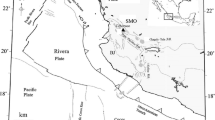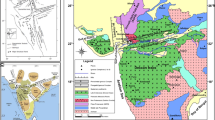Summary
The structures of the Somma-Vesuvius volcanic complex are modelled on the basis of the interpretation of gravity anomalies obtained from data available in the literature and acquired along a new profile along the coastline from Naples to Castellammare di Stabia. In order to highlight the contribution of shallow crustal structures, the residual anomalies were considered. A marked gravity low was recognised in the eastern sector of Vesuvius. Furthermore data interpretation was carried out along two profiles centred on the low gravity region in question: a first profile crossing the Vesuvius crater in direction WNW-ESE, and a second one in NNE-SSW direction. The 2 ½ D model obtained reveals a crustal structure characterised by sediments of 2.3 Mg/m3 density, overlying bedrock with a density of 2.6 Mg/m3. Near the volcanic system the model becomes more complex due to the presence of light sediments with a density of 2.1 Mg/m3 overlying a body with a density of 2.4 Mg/m3 which extends into depth. The latter is thought to be closely related to the zone of magma ascent developed along the volcanic axis. Along the coast the volcanic component is reduced and the model shows that the layer with a density of 2.3 Mg/m3 ranges in thickness from 0 to about 3500 m. An additional body between 1500 and 3000 m with a density of 2.4 Mg/m3 was considered in order to account for the slight rise in the residual anomaly in the area in the vicinity of Mt. Vesuvius.
The analysis of the gravity anomaly pattern coincides with the complex system of faults and fractures intersecting the carbonate basement and the volcanic area in question, which developed as a consequence of extensional processes at the continental edge of the Italian Peninsula due to the opening of the Tyrrhenian basin. This extensional tectonics has created favourable conditions for the collapse of the south-western slope of Mt. Vesuvius and the development of eruptive vents and cracks on its flanks.
Similar content being viewed by others
Author information
Authors and Affiliations
Additional information
Received May 18, 2000; revised version accepted March 6, 2001
Rights and permissions
About this article
Cite this article
Cubellis, E., Ferri, M., Luongo, G. et al. The roots of Mt. Vesuvius deduced from gravity anomalies. Mineralogy and Petrology 73, 23–38 (2001). https://doi.org/10.1007/s007100170008
Issue Date:
DOI: https://doi.org/10.1007/s007100170008




